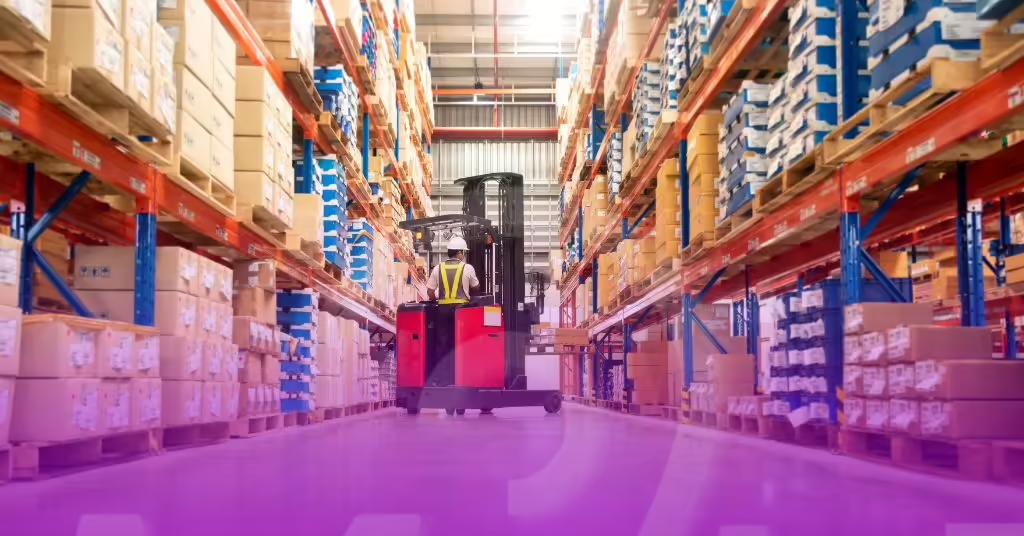Warehouse quality control refers to the set of processes a warehouse undertakes to ensure that the stored inventory meets industry standards. It focuses on inspecting products for damage, assessing product quality consistency, and ensuring that shipments leave the warehouse in pristine condition.
Without a warehouse quality control workflow in place, your order fulfillment operations can quickly spiral into chaos. Miscounted inventory leads to stockouts or excess stock. Damaged or defective goods may slip through unnoticed and result in customer complaints, returns, and reputational harm.
Shipping the wrong products/quantities or mislabeling them can cause unnecessary shipment discrepancies at the carrier’s end and in turn, mistrust in your business practices. Mishandled perishable or sensitive goods, too, can add unnecessary costs to your tally. Worse yet, you put your employees’ health at risk if there are no standard operating procedures in place to handle hazardous items safely.
Why Is Warehouse Quality Control Important?
In a nutshell, warehouse quality control is important because it helps maintain the safety and quality of stored items, both of which are essential for customer satisfaction. Here are a few reasons why you should implement proper quality control measures at your warehouse.
Regulatory Compliance
Quality control ensures that businesses comply with industry standards and legal regulations. Failure to do so can result in product recalls, lawsuits, or fines. Adherence helps businesses prevent legal exposure, financial risks and potential litigation.
Cost Savings
It can be very expensive to dispose of or rework products with poor quality. Sometimes, customers can also get physically injured by defective items and report a liability claim against you, which would again be quite costly. Have a comprehensive warehouse quality control and save all this money.
Customer Satisfaction
A solid quality control workflow ensures that your products always fulfill or surpass customer expectations. Consistent quality is a sure-fire way to build customer trust, boost conversion rates, and encourage long-term loyalty.
Brand Reputation
Product quality is directly related to a brand’s reputation. Customers are more likely to purchase from businesses that are known to uphold high quality standards. Quality control processes like early inspections in the supply chain, keep defective items out of circulation, and protect your brand’s credibility.
Warehouse Quality Control vs. Warehouse Quality Assurance: What’s the Difference?
Though both terms focus on evaluating a warehouse’s performance, quality control and quality assurance serve different purposes.
Warehouse quality control inspects and assesses products at the batch level to ensure they are stored and packed as per quality standards before being shipped. For example, if 100 pallets are prepared for shipment, quality control examines the group as a batch and inspects them to verify that all items match the required size, shape, color, etc. If one pallet contains faulty items, it is flagged as a quality issue within that batch.
On the other hand, warehouse quality assurance focuses on improving processes throughout the warehouse to prevent defects from occurring in the first place. It ensures that each step, whether related to storage, handling, or packaging, is according to predefined standards. Instead of examining batches, quality assurance works to eliminate risks across all operations. For example, if you organize training programs for your warehouse staff on proper handling of fragile items to reduce breakage during storage or transit, that’ll be a part of your quality assurance strategy.
In short, warehouse quality control identifies problems in finished batches, so that only compliant products are shipped and delivered to the end customer. Meanwhile, warehouse quality assurance builds preventive measures into daily operations for long-term improvements. When used together, both these processes help maintain product quality and improve workflow efficiency.
Common Challenges in Warehouse Quality Control
Inconsistent Product Quality
It’s often difficult to keep quality standards uniform across inventory. This is mainly because products received from different suppliers or production batches may differ in quality.
Example: A batch of clothing from one supplier has stitching defects, but another batch from a different supplier is of excellent quality.
Solution: Implement supplier audits and quality benchmarks to ensure consistency across all shipments.
Human Errors in Inspection
Manual inspection, though necessary, is still prone to errors. It’s possible that your staff unintentionally overlooks or misjudges a defect.
Example: A worker misses scratches on a pallet of electronics during a busy shift. The customer requests a return upon receiving the product.
Solution: Use barcode scanners, checklists, and automated quality control tools to reduce dependency on manual inspections.
Time Constraints During Peak Seasons
Customer demand is sky-high during peak seasons, and there’s barely any time to spare to inspect each and every product inside out. Consequently, shipments are rushed through without adequate quality checks.
Example: During Christmas, a warehouse churn out orders quickly to ensure timely deliveries. They reach the customers, often with packaging issues or missing items.
Solution: Use random sampling methods and reinforce quality teams during high-demand periods to maintain inspection standards.
Poor Storage Conditions
Inadequate storage environments can compromise the quality of products, especially those that require specific temperature or humidity levels.
Example: Your storage team stores chocolates in a non-temperature-controlled area. They melt and lose their structural integrity.
Solution: Install climate control systems and real-time monitoring tools to guarantee appropriate conditions for sensitive products.
Inconsistent Quality Procedures Across Shifts
In a regular warehouse, usually it so happens that there are different tasks for different shifts to ensure a fair and equitable workload distribution. As a result, inconsistent standards become unavoidable, and the chances of missing defects grow higher.
Example: The morning shift may check samples, while the night shift inspects only product labels.
Solution: Develop standardized operating procedures (SOPs) and conduct regular staff training to ensure consistency across all shifts.
Supplier Non-Compliance
Suppliers may not always follow agreed quality standards and dispatch defective products to the warehouse. Identifying these issues late complicates product returns and order fulfillment.
Example: A supplier delivers a batch of furniture with missing screws, which is discovered only after the product reaches customers.
Solution: Establish quality agreements with suppliers and perform regular audits to ensure compliance.
High Costs Due to Returns and Rework
Shipping a defective product almost always means an extra financial and operational cost to manage its reverse logistics.
Example: Customers return a batch of faulty smartphones and request a repair or replacement.
Solution: Implement multi-stage quality checks to catch defects early and reduce rework costs.
6 Best Practices for Warehouse Quality Control
Below are six best practices that will help your warehouse increase operational accuracy and customer satisfaction.
1. Set Clear Quality Control Objectives
Start by defining measurable goals that align with your business objectives. These may include target shipping accuracy, reduction in damaged goods, or compliance with delivery timelines. Clear objectives provide direction and allow you to track progress effectively.
Pro Tip: Use KPIs like order accuracy, damage rate, and return frequency to monitor your operations.
2. Create and Follow Standard Operating Procedures (SOPs)
Well-documented SOPs reduce human errors and ensure a consistently smooth flow of operations. These procedures outline specific instructions for all key processes involved in a warehouse management workflow, from inbound receiving to reverse logistics.
Pro Tip: Regularly update SOPs to reflect industry changes or introduce new best practices.
3. Inspect Products in Batches
Rather than reviewing every item individually, inspect them in batches. This will allow for efficient quality control without sacrificing accuracy. Random sampling also helps detect defects before a shipment reaches customers. For example, you can randomly check 100 units in a batch of 1,000 items. If you find any issues within the sample, you can send the entire batch for further scrutiny.
Pro Tip: Introduce acceptance sampling plans to set clear thresholds for acceptable defect levels.
4. Conduct Routine Audits
Besides ensuring compliance to company policies and regulatory standards, regular audits will help you identify bottlenecks and highlight areas needing improvement. For instance, a quality audit might reveal that a few temperature-sensitive goods got spoiled because a section of the warehouse lacks proper ventilation.
Pro Tip: Schedule surprise inspections to check whether employees follow procedures or not.
5. Monitor Daily Operations
Track daily performance to be able to respond quickly to recurring trends or problems. For example, if your warehouse manager reviews daily order accuracy reports and notices a repeated mistake in one shift, they can adjust staffing and retrain the shift to resolve the issue immediately.
Pro Tip: Use dashboards to visualize data and provide teams with real-time feedback on their performance.
6. Consider Warehouse Automation
Invest in a warehouse management system (WMS), a specialized type of inventory management software that streamlines the movement of goods in and out of storage. Some WMS solutions also incorporate barcode scanning, RFID tracking, and other advanced tools to:
- Automate incoming goods inspection.
- Devise a plan for warehouse layout optimization.
- Monitor inventory levels and locations.
- Ensure accurate order picking.
- Update inventory as items enter and leave the warehouse.
- Conduct inventory audits regularly.
- Track product movement after dispatch.
- Manage returns and exchanges seamlessly.
Pro Tip: Implement Mile’s WMS.
Schedule a demo today to learn more about Mile and our robust WMS solutions.

